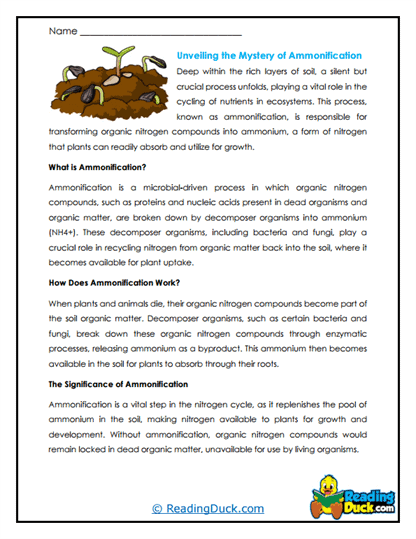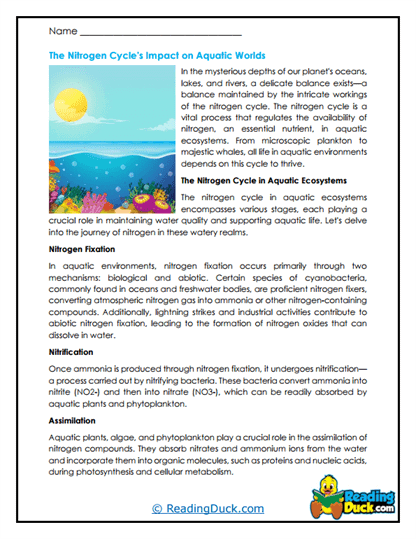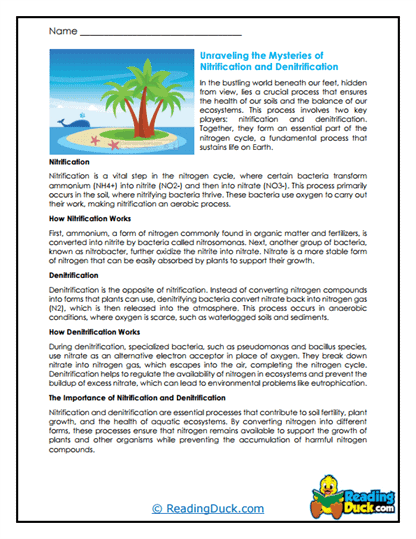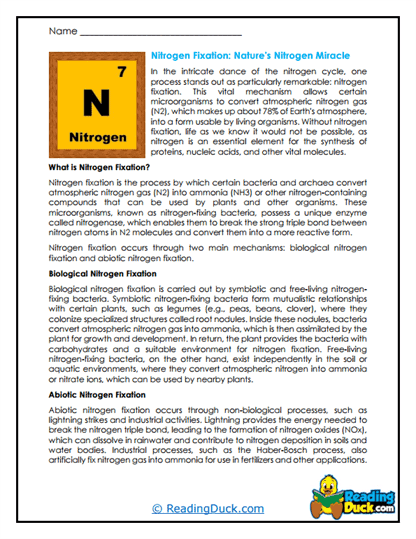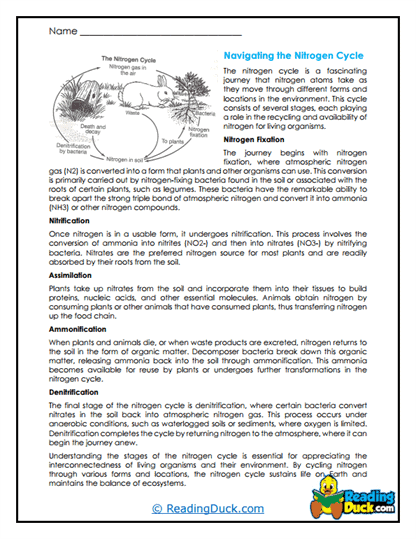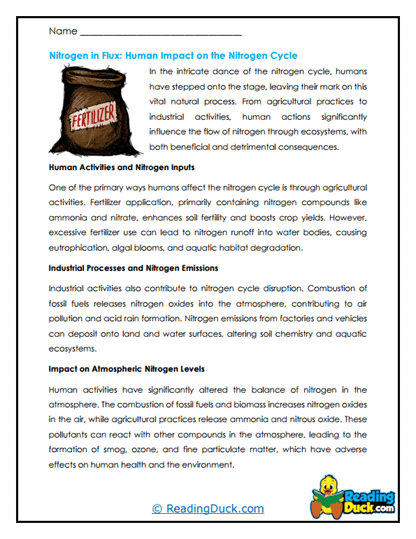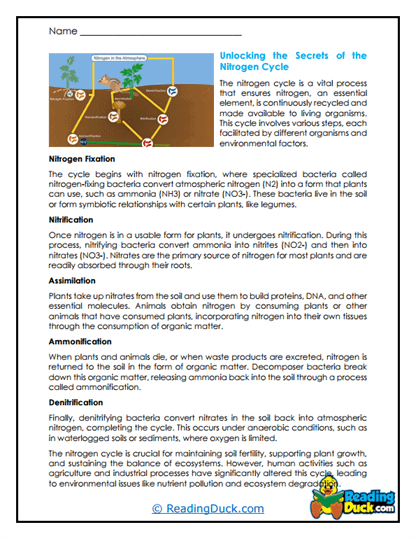Nitrogen Cycle Worksheets
About Our Nitrogen Cycle Worksheets
Our collection of Nitrogen Cycle worksheets offers an engaging and comprehensive exploration of a vital process in Biology and Environmental Sciences: the nitrogen cycle. The nitrogen cycle is essential for understanding how nitrogen, a crucial element for life, moves through different parts of the Earth’s ecosystem, including the atmosphere, soil, and living organisms. These worksheets are designed to deepen students' knowledge of the nitrogen cycle, its significance, and its impact on both natural ecosystems and human activities.
This collection is a subtopic within Biology and Environmental Sciences and contains several worksheet sets. Each worksheet set includes:
- Multiple Choice Questions: These questions assess students' comprehension of the reading passage, ensuring they grasp the key concepts and details presented.
- Short Answer Questions: This section prompts students to write their responses, encouraging them to articulate their understanding in their own words. This exercise helps reinforce their knowledge and improves their ability to communicate scientific information effectively.
- Open-Ended Questions: These questions invite students to share their personal thoughts, opinions, and reflections on the material, fostering critical thinking and allowing them to connect more deeply with the content.
Each worksheet is accompanied by a detailed answer key, making it easy for educators and parents to review students' work. The worksheets are provided in PDF format, ensuring they can be easily viewed electronically, downloaded, and printed.
Understanding the Nitrogen Cycle: Nature's Recycling Process
The nitrogen cycle is a complex process that transforms nitrogen into various chemical forms, making it available for use by plants, animals, and other organisms. Nitrogen is a crucial component of amino acids, proteins, and DNA, making it essential for all living organisms. When introducing students to the nitrogen cycle, it’s important to highlight its role in sustaining life, the intricate processes involved, and the impact of human activities on this delicate balance.
The Basics of the Nitrogen Cycle: The nitrogen cycle involves several key processes that convert nitrogen into forms that can be used by living organisms:
- Nitrogen Fixation: This process converts atmospheric nitrogen (N₂), which most organisms cannot use directly, into ammonia (NH₃) or related compounds that can be absorbed by plants. Nitrogen fixation occurs naturally through lightning, which breaks the bonds of atmospheric nitrogen, and through certain bacteria that live in the soil or in the roots of leguminous plants, such as beans and peas.
- Nitrification: Ammonia in the soil is converted into nitrites (NO₂⁻) and then into nitrates (NO₃⁻) by nitrifying bacteria. Nitrates are a form of nitrogen that plants can easily absorb and use to build proteins and other essential molecules.
- Assimilation: Plants take up nitrates from the soil and incorporate them into plant tissues. When animals eat plants, they assimilate the nitrogen into their own tissues, continuing the cycle through the food web.
- Ammonification: When plants and animals die, decomposers break down the organic matter, converting the nitrogen back into ammonia or ammonium ions (NH₄⁺), which can be used by plants again or further processed by nitrifying bacteria.
- Denitrification: Some bacteria convert nitrates back into nitrogen gas (N₂), which is released into the atmosphere, completing the cycle. This process occurs in anaerobic conditions, such as waterlogged soils or wetlands.
Human Impact on the Nitrogen Cycle: Human activities have significantly altered the natural nitrogen cycle, leading to various environmental consequences:
- Fertilizer Use: The widespread use of synthetic fertilizers in agriculture introduces large amounts of nitrogen into the soil. While this boosts crop production, it also leads to an excess of nitrates, which can leach into waterways, causing problems like algal blooms and water pollution. This process, known as eutrophication, depletes oxygen in the water, harming aquatic life.
- Burning Fossil Fuels: Combustion of fossil fuels releases nitrogen oxides (NOx) into the atmosphere, contributing to air pollution and the formation of smog and acid rain. These pollutants can damage ecosystems, acidify soils and water bodies, and negatively affect human health.
- Deforestation: The removal of forests disrupts the nitrogen cycle by reducing the number of plants that can absorb nitrates and by altering the soil’s microbial communities. Deforestation can lead to increased nitrogen runoff and loss of soil fertility.
- Industrial Activities: Industrial processes that release nitrogen compounds into the environment can also impact the nitrogen cycle. For example, the production of fertilizers and the discharge of industrial waste contribute to nitrogen pollution in both air and water.
Ecological and Agricultural Importance of the Nitrogen Cycle: The nitrogen cycle is critical for both natural ecosystems and agricultural productivity:
- Soil Fertility: The availability of nitrogen in the soil is a key factor in determining soil fertility and plant growth. Farmers rely on the nitrogen cycle to ensure their crops receive the nutrients they need. Understanding the nitrogen cycle helps in managing soil health and optimizing the use of fertilizers to avoid over-fertilization and environmental damage.
- Ecosystem Health: In natural ecosystems, the nitrogen cycle supports plant diversity and productivity, which in turn supports animal populations. Disruptions to the nitrogen cycle can lead to changes in species composition and the functioning of ecosystems, with far-reaching consequences for biodiversity and ecosystem services.
- Climate Regulation: Nitrous oxide (N₂O), a byproduct of the nitrogen cycle, is a potent greenhouse gas that contributes to global warming. Managing nitrogen emissions is an important aspect of climate change mitigation strategies.
Global Nitrogen Management: Addressing the challenges posed by human impacts on the nitrogen cycle requires coordinated efforts at local, national, and global levels:
- Sustainable Agriculture: Practices such as precision farming, crop rotation, and the use of organic fertilizers can help optimize nitrogen use, reduce environmental impacts, and maintain soil health. Sustainable agriculture aims to balance the need for food production with the need to protect natural resources.
- Pollution Control: Reducing nitrogen emissions from industrial and transportation sources, as well as improving wastewater treatment, can help mitigate the negative effects of nitrogen pollution. Policies that regulate nitrogen emissions and promote cleaner technologies are essential for protecting the environment and human health.
- Restoration Projects: Efforts to restore degraded ecosystems, such as reforestation and wetland restoration, can help reestablish natural nitrogen cycles. These projects often involve reintroducing native plant species, improving soil health, and managing water resources to support the recovery of ecological balance.
By exploring these aspects of the nitrogen cycle, students will gain a comprehensive understanding of how nitrogen moves through ecosystems, the impact of human activities, and the importance of managing this critical nutrient. These worksheets will guide students through the fundamental concepts of the nitrogen cycle, encouraging them to think critically about the connections between natural processes and human influences.
Creative Uses For These Worksheets
Here are four creative ideas on how teachers and parents can use these Nitrogen Cycle worksheets in school or in a homeschool setup:
- Nitrogen Cycle Diagram Creation: Have students create detailed diagrams of the nitrogen cycle, illustrating each process and the role of different organisms. They can use the worksheets to label each step, explain the chemical transformations, and highlight human impacts on the cycle. This visual project helps students reinforce their understanding of complex processes.
- Classroom Experiment on Nitrogen Fixation: Conduct a simple experiment where students grow plants in different types of soil, including one with nitrogen-fixing bacteria and one without. Students can use the worksheets to track plant growth, observe differences, and discuss the role of nitrogen fixation in agriculture and natural ecosystems.
- Role-Playing the Nitrogen Cycle: Organize a role-playing activity where students take on the roles of various components in the nitrogen cycle, such as nitrogen-fixing bacteria, plants, consumers, and decomposers. The worksheets can provide background knowledge, and students can act out the processes, demonstrating how nitrogen moves through an ecosystem.
- Nitrogen Footprint Project: Assign students to research and calculate their nitrogen footprint, exploring how their daily activities contribute to nitrogen emissions. Using the worksheets, they can identify ways to reduce their impact, such as changing dietary choices, reducing energy consumption, and supporting sustainable practices. This project encourages personal responsibility and real-world application of their learning.
The Importance of Learning About the Nitrogen Cycle
Understanding the nitrogen cycle is essential for students because it provides foundational knowledge of how vital nutrients circulate through ecosystems and sustain life. Academically, it deepens their understanding of biology, environmental science, and the complex interactions within natural systems. On a personal level, learning about the nitrogen cycle empowers students to recognize the impact of human activities on the environment and the importance of sustainable practices. By understanding the nitrogen cycle, students are better equipped to make informed decisions that contribute to the health and sustainability of our planet for future generations.
